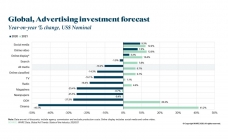Advertising weathered 2020 storm relatively well: GroupM report
By M4G Bureau - December 07, 2020
Outdoor advertising is estimated to decline by 31% during 2020, including DOOH media; Next year would see a partial rebound, with 18% growth
This year will, in some ways, be remembered as more of a mild setback than an industry-changing economic catastrophe for the media business, cites GroupM’s ‘This Year Next Year: Global End-Of-Year Forecast’ released this month.
Despite the grim realities of a global economy that will be the worst since the Great Depression, advertising weathered the storm relatively well and will end up declining by “only” 5.8% on an underlying basis (excluding-U.S. political advertising). This is a much better expectation than our June forecast of an 11.9% decline for 2020, but still a sharp fall from 2019’s 8.7% growth rate, the report says.
 To simplify, the nature of the downturn and new consumer behaviour forced businesses to rapidly adapt to e-commerce models, and digital advertising benefitted. This is the new baseline from which e-commerce is expected to keep growing and, along with it, performance-based marketing. As such, we’ve updated our 2021 outlook for the global advertising market from our June forecast of 8.2% to 12.3% growth.
To simplify, the nature of the downturn and new consumer behaviour forced businesses to rapidly adapt to e-commerce models, and digital advertising benefitted. This is the new baseline from which e-commerce is expected to keep growing and, along with it, performance-based marketing. As such, we’ve updated our 2021 outlook for the global advertising market from our June forecast of 8.2% to 12.3% growth.
Looking at the eight largest markets—the U.S., China, Japan, the U.K., Germany, France, South Korea and Canada—we expect seven of them to see declining growth of nearly 2% and worse in 2020. The exception is China where we expect a rate of growth at 6.2%. The good news, though, is we expect all these countries to show growth in 2021: 11.8% in the U.S., 15.6% in China, 12% in Japan, 12.4% in the U.K., 4.6% in Germany, 7.2% in France, 1.6% in South Korea and 15.1% in Canada, the report adds.
Six key takeaways from This Year, Next Year: Global 2020 End-of-Year Forecast Report are:
- Digital advertising is expected to grow by 8.2% during 2020, excluding U.S. political activity. This follows nearly a decade of double-digit growth, including the last six years, when it was better than 20% globally.
- Digital advertising for pure-play media owners like Amazon, Facebook, Google, etc., should be 61% of advertising in 2021. This share has doubled since 2015 when it was only 30.6%.
- By 2024, we estimate digital advertising will have a 66% share globally.
- Television advertising will decline by 15.1% excluding U.S. political advertising, before rebounding to grow 7.8% next year.
- Digital extensions and related media, including advertising associated with traditional media owners’ streaming activities (primarily on connected environments), will grow 7.8% this year and 23.2% next year.
- Outdoor advertising is estimated to decline by 31% during 2020, including digital out-of-home media. Next year would see a partial rebound, with 18% growth.
- Beyond 2021, outdoor advertising is expected to grow by low- or mid-single digits and generally lose share of total advertising; however, “we do expect larger brands generally to allocate more of their budgets to the medium”.
- Cinema is newly separated in our global forecast for markets where data could reasonably be estimated. The global sector likely generated less than $3 billion during 2019 and likely fell more than 75% during 2020 given the absence of major studio releases in most markets around the world.
- Print advertising, including newspapers and magazines, is expected to decline 5% for the year, a significant acceleration over the high-single-digit declines of recent years. However, those single-digital declines should resume following an economic recovery.
- Audio advertising is likely to decline by 24% during 2020 as advertisers disinvest, in part, because of the medium’s dependence on away-from-home activities, such as driving. Digital extensions, including streaming services from terrestrial stations and their digitally-oriented competitors and podcasts, still attract relatively small audiences of a few billion, but help make the broader medium more appealing to marketers.

Stay on top of OOH media trends








